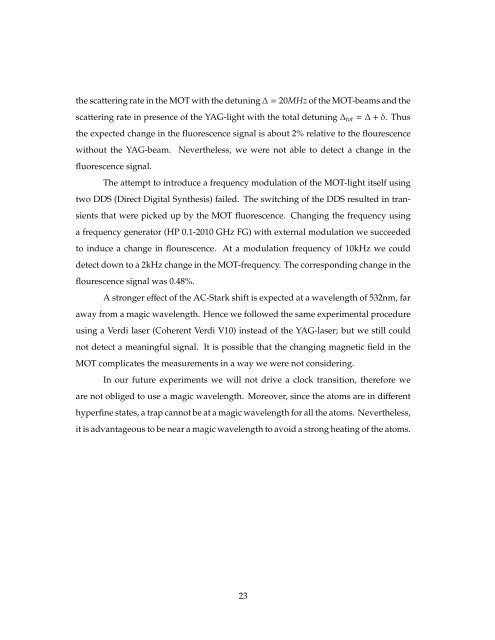Copyright by Kirsten Viering 2006 - Raizen Lab - The University of ...
Copyright by Kirsten Viering 2006 - Raizen Lab - The University of ...
Copyright by Kirsten Viering 2006 - Raizen Lab - The University of ...
You also want an ePaper? Increase the reach of your titles
YUMPU automatically turns print PDFs into web optimized ePapers that Google loves.
the scattering rate in the MOT with the detuning ∆ = 20MHz <strong>of</strong> the MOT-beams and the<br />
scattering rate in presence <strong>of</strong> the YAG-light with the total detuning ∆tot = ∆ + δ. Thus<br />
the expected change in the fluorescence signal is about 2% relative to the flourescence<br />
without the YAG-beam. Nevertheless, we were not able to detect a change in the<br />
fluorescence signal.<br />
<strong>The</strong> attempt to introduce a frequency modulation <strong>of</strong> the MOT-light itself using<br />
two DDS (Direct Digital Synthesis) failed. <strong>The</strong> switching <strong>of</strong> the DDS resulted in tran-<br />
sients that were picked up <strong>by</strong> the MOT fluorescence. Changing the frequency using<br />
a frequency generator (HP 0.1-2010 GHz FG) with external modulation we succeeded<br />
to induce a change in flourescence. At a modulation frequency <strong>of</strong> 10kHz we could<br />
detect down to a 2kHz change in the MOT-frequency. <strong>The</strong> corresponding change in the<br />
flourescence signal was 0.48%.<br />
A stronger effect <strong>of</strong> the AC-Stark shift is expected at a wavelength <strong>of</strong> 532nm, far<br />
away from a magic wavelength. Hence we followed the same experimental procedure<br />
using a Verdi laser (Coherent Verdi V10) instead <strong>of</strong> the YAG-laser; but we still could<br />
not detect a meaningful signal. It is possible that the changing magnetic field in the<br />
MOT complicates the measurements in a way we were not considering.<br />
In our future experiments we will not drive a clock transition, therefore we<br />
are not obliged to use a magic wavelength. Moreover, since the atoms are in different<br />
hyperfine states, a trap cannot be at a magic wavelength for all the atoms. Nevertheless,<br />
it is advantageous to be near a magic wavelength to avoid a strong heating <strong>of</strong> the atoms.<br />
23
















